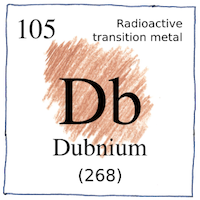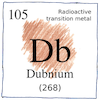Dubnium
The Soviets bombarded americium-243 with neon-22 ions and looked for a new alpha emission energy for an isotope of element 105, but they figured it was obscured by emissions from the decay of uranium synthesized from lead impurities in the americium target. So they began to look for a new half-life and found one, around two seconds, which they said was from an isotope of 105. * The Americans bombarded californium-249 with nitrogen-15 ions and found an alpha emission that overlapped with the noise that obscured results for the Soviets. * The Soviets removed their lead impurities ran the experiment again, and found the same alpha emission plus decay chains involving lawrencium, which meant that the Soviets had originally found either dubnium-260 or dubnium-261, although its half-life best matched dubnium-260.
Atomic number 105
The longest lived isotope, dubnium-268, decays by half in twenty-nine hours, leaving various isotopes by spontaneous fission and rutherfordium-268 by electron capture. The shortest lived isotope, dubnium-259, decays by half in half a second, leaving, by alpha emission, lawrencium-255, which, in its turn, decays.
Pattern
All the heavy elements decay. If they had no other interest, all they would be would be an equal weight of lead. But they sparkle, they scintillate, they drop hints about old connections. Eventually, you would think, a pattern would emerge that might solve the problems of the world.




If it weren’t for the unknown, our knowlege would be less interesting.
See also in The book of science:
Readings in wikipedia:
Other readings: